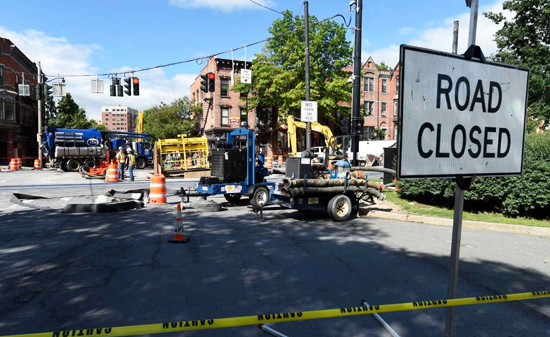Experts Q&A: Rebuilding U.S. Infrastructure
 |
|
President Trump has proposed investing $1 trillion to fix U.S. infrastructure, including roads, waterways, bridges and airports. (Photo by Skip Dickstein, Times
Union used by permission)
|
ALBANY, N.Y. (March 16, 2017) -- In his joint address to Congress on February 28, President Donald J. Trump called for $1 trillion in infrastructure spending to fix America’s bridges, roadways, waterways and broadband networks. Critics and colleagues alike are in agreement that the investment is needed, and that $1 trillion is likely only a fraction of the cost.
According to the American Society of Civil Engineers and as reported by CNN Money, “the nation’s roads, dams, airports and water and electrical systems need $4.6 trillion of work -- more than the entire federal government spends in a year. to fix the crumbling U.S. infrastructure.”
This begs the question, will $1 trillion be enough to help address the problem, and how does the U.S. government, with more than $20 trillion in debt, pay for the bill?
University at Albany Distinguished Professor of Economics Kajal Lahiri is an expert on economic forecasting and applied econometrics. He developed the U.S. Department of Transportation’s Transportation Services Index, which serves as a leading indicator of where the U.S. Economy is headed.
Q: Is a $1 trillion investment needed, and where is it needed?
Certainly, there are areas where the infrastructure needs additional investment. Our interstate highway system is the best in the world, but the railways and many airports look primitive. Compared with Europe and Japan, our economy is yet to be connected by high-speed rails. Taking two and half hours to go from Albany to New York City by Amtrak is ridiculous. However, $1 trillion is a very big number -- compare this with the total U.S. government revenue of $3.6 trillion for the fiscal year 2017.
 |
|
Distinguished Professor of Economics Kajal Lahiri
|
President Obama’s 2009 Economic Stimulus package (TARP) to save the economy from the brink of a disaster was $787 billion. It is now well known that the effect of this spending was best for transportation and aid for low-income families (Medicaid) with a multiplier value of around two. However, for other types of spending like those on education, research, state and local governments, etc. were marginally effective, at best.
Q: How is ‘infrastructure’ a critical component of the U.S. Economy?
Being able to move goods and people seamlessly across the country is critical for economic growth. Pipelines for moving natural gas and oil are also equally important. These are like blood flow through veins in a human body. The organization of the country in terms of five Petroleum Administration for Defense Districts (PADD) has remain unchanged since the World War II. Transportation facilitates business activities, and thus is critical for an economy to grow.
Q: Part of President Trump’s guiding principles are "Buy American, Hire American." Will this principle help or hurt the investment, and if so how?
Given the current unemployment rate of less than 5 percent and the abundance of domestically available foreign goods, “Buy American, Hire American” slogan troubles me. Notwithstanding private-public partnerships, where would all the additional workers come from? Not surprisingly, groups such as the American Society of Civil Engineers have an interest in triggering as much public spending as possible and want a lot more than $1 trillion. Equally troubling is the “Buy American” push. This will only create inflation that may not be palatable to many consumers.
The timing of the infrastructural investment is also critical. It may work if this spending is initiated opportunistically when the economy is in an economic recession with widespread unemployment. Otherwise, we will see massive budget deficits and inflation. We should not forget that every 8-10 years we get a recession and our last recession ended in June 2009. So wait for it.
Q: In 2004 you worked with the U.S. Dept. of Transportation to launch the Transportation Services Index. What does this index say about the current health of the U.S. Economy, and how would an infrastructure investment impact it?
Indeed, during 2000-01 with a grant from the US Department of Transportation, I developed the Transportation Services Index (TSI). Since June 2009, which was the official end of the 2007-09 recession, both the freight and passenger components of TSI have been trending up with occasional gyrations. My research has established that TSI is a long-leading indicator of a recession. Thus, the time to worry about an impending recession has not yet come. The Transportation Services Index gives a graphical view of TSI since 2000.
More than 40 percent of the transportation sector is trucking. With construction and work on roads and bridges, this industry is sure to get a huge boost.
Q: What are your current areas of research at UAlbany?
Currently I am working on non-linear forecasting models for recession prediction and, in addition, deeply involved a 5-year project evaluating the State Medicaid program. The latter is the other part of my long-standing research interest that deals with disability and health in the vulnerable sections of our society.
![]() For more news, subscribe to UAlbany's RSS headline feeds
For more news, subscribe to UAlbany's RSS headline feeds
A comprehensive public research university, the University at Albany-SUNY offers more than 120 undergraduate majors and minors and 125 master's, doctoral and graduate certificate programs. UAlbany is a leader among all New York State colleges and universities in such diverse fields as atmospheric and environmental sciences, business, education, public health,health sciences, criminal justice, emergency preparedness, engineering and applied sciences, informatics, public administration, social welfare and sociology, taught by an extensive roster of faculty experts. It also offers expanded academic and research opportunities for students through an affiliation with Albany Law School. With a curriculum enhanced by 600 study-abroad opportunities, UAlbany launches great careers.


